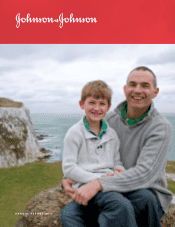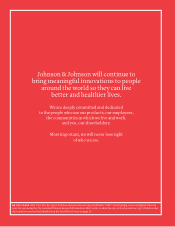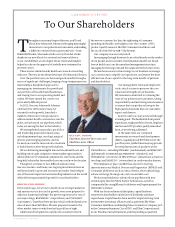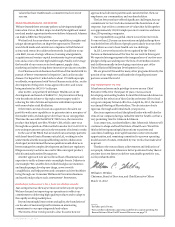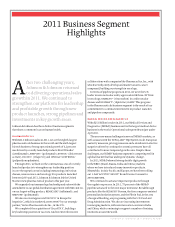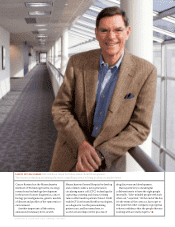Johnson and Johnson 2011 Annual Report Download - page 10
Download and view the complete annual report
Please find page 10 of the 2011 Johnson and Johnson annual report below. You can navigate through the pages in the report by either clicking on the pages listed below, or by using the keyword search tool below to find specific information within the annual report.
JOHNSON & JOHNSON 2011 ANNUAL REPORT8
Vaccines are fundamentally
different from pharmaceutical
medicines.
“A vaccine prepares
the body for whenever a virus
attacks you,” explains Jaap
Goudsmit, Chief Scientific
Officer, Crucell N.V. “You
vaccinate healthy people,
whereas drugs are used to treat
sick people. The aim of
vaccination is to prevent
disease.”
It takes more than scientific
expertise. As our Pharmaceu-
ticals business grows beyond
a treatment model to one
that includes prevention with
vaccines, an equally important
consideration is the ability to
make hundreds of millions
of doses of vaccine at a price
that’s affordable for the
majority of the globe.
That’s what Crucell,
acquired by an affiliate of
Johnson & Johnson in
February 2011, is working
to do with a new, ultramodern
manufacturing facility in
Incheon, South Korea.
One of the largest such
facilities in the world, it is
capable of making more than
100 million doses per year
of pentavalent vaccine,
a combination of five vaccines
in one: diphtheria, tetanus,
whooping cough, hepatitis B
and haemophilus influenza
type b (the bacteria that
causes meningitis, pneumonia
and otitis). The facility makes
half of all the pentavalent
vaccine used worldwide by
UNICEF, the world’s largest
distributor of childhood
vaccines.
Crucell is also working to
evaluate possibilities of using
vaccines beyond preventing
infectious diseases. One area of
focus is prevention of diseases
of the elderly, such as certain
cancers and Alzheimer’s
disease.
“We dream of a world
where there are no more
infectious diseases,” says Johan
Van Hoof, Managing Director,
Crucell. “Or where there are
infectious diseases, they’re
under control.”
INCIVO® (telaprevir)*, a new
direct-acting antiviral protease
inhibitor for the treatment of
genotype 1** chronic hepatitis C
virus (HCV) in combination
with pegylated interferon and
ribavirin, was approved in
European Member States in
September 2011. “The arrival
of direct-acting antivirals will
offer more patients hope for
a cure,” says Charles Gore,
President, World Hepatitis
Alliance.
According to the World
Health Organization, about
170 million people worldwide
are infected with hepatitis C.
Because it can have serious
long-term health consequences
—such as cirrhosis, liver
cancer and liver transplanta-
tion—hepatitis C carries a high
economic burden for patients
and society.
Named one of the top 10
medical innovations of 2011 by
the Cleveland Clinic, telaprevir
doubles the chances of clearing
the virus in half the treatment
time compared with prior
standard treatments in the
majority of HCV genotype 1
patients.
Jim Witek, Global Medical
Affairs Leader for INCIVO®,
says this product is a new
highlight of the Janssen
Pharmaceutical Companies’
expanding infectious disease
portfolio. “Our R&D in serious
infections such as HIV/AIDS,
HCV and tuberculosis has
allowed us to bring innovative
therapies that are helping to
redefine and improve treat-
ment outcomes,” he says.
* INCIVO® (telaprevir) was co-developed
by Vertex Pharmaceuticals and Tibotec,
an affiliate of Janssen Pharmaceutical
Companies of Johnson & Johnson.
The Janssen Companies have the right to
commercialize telaprevir in Europe, Latin
America, the Middle East, Africa, India,
Australia and New Zealand under the
commercial name INCIVO®.
** The most common genotype in Europe
and the U.S.
Moving From Treatment
to Prevention
Curing
Hepatitis C
MANUFACTURING VACCINES
Kyung Mi Choi works at
Crucell’s ultramodern vaccine
manufacturing facility,
which opened in 2011 in
Incheon, South Korea.
It is one of the largest such
facilities in the world.

